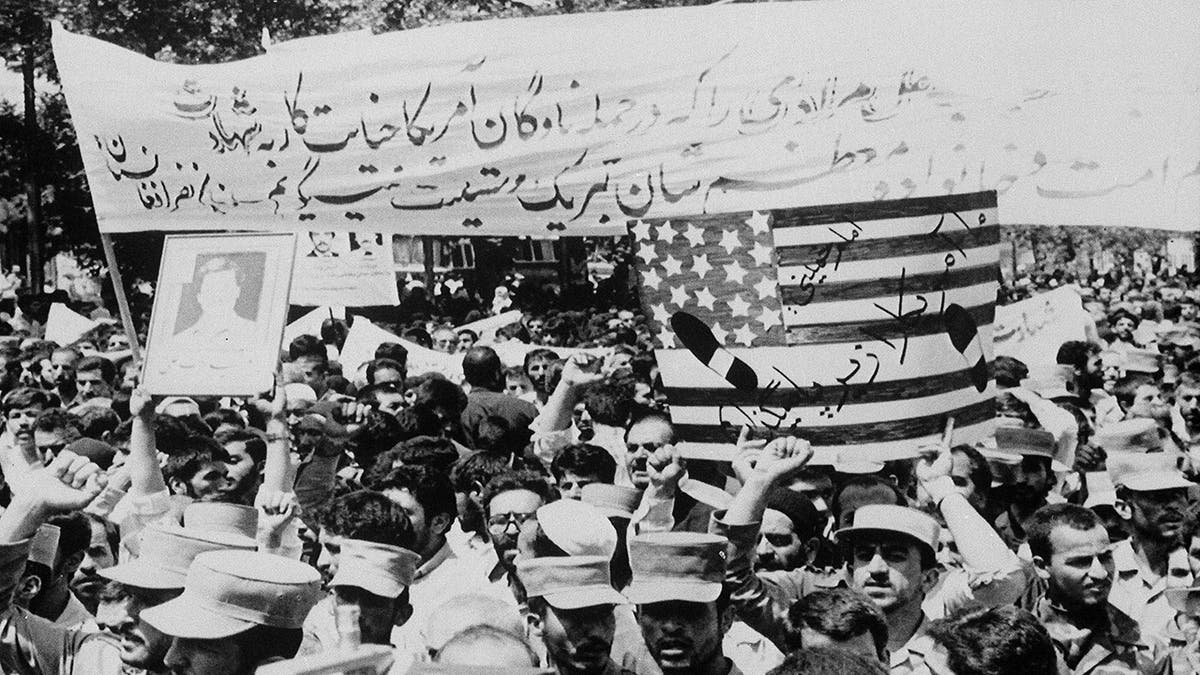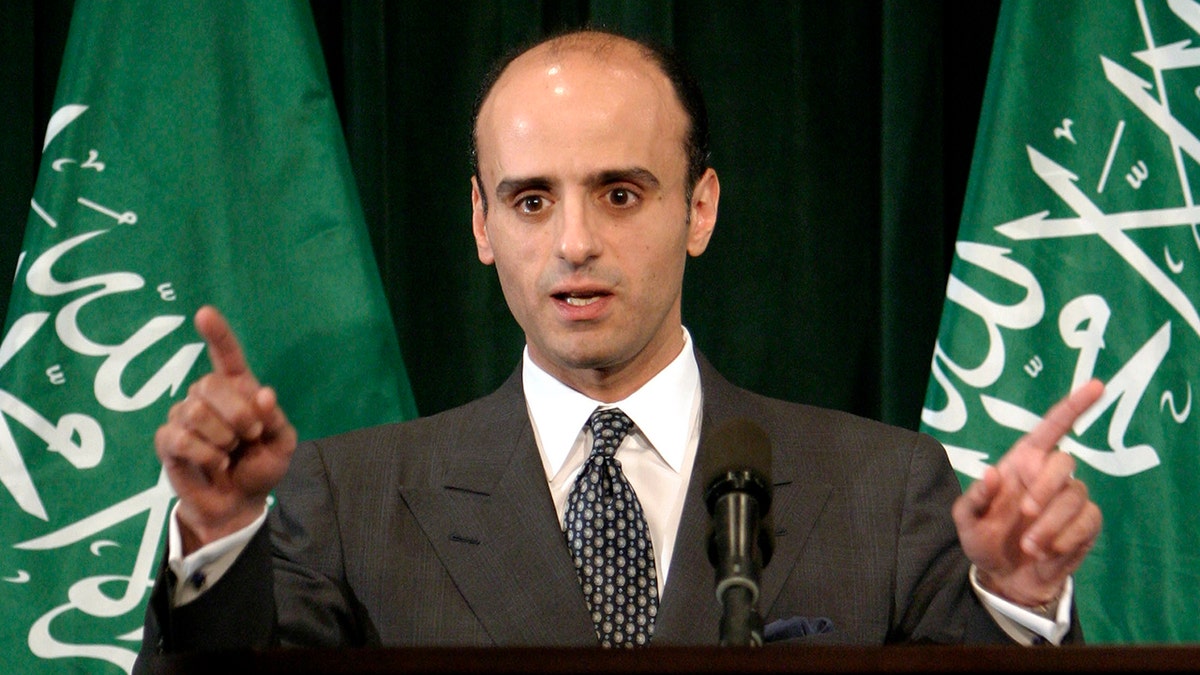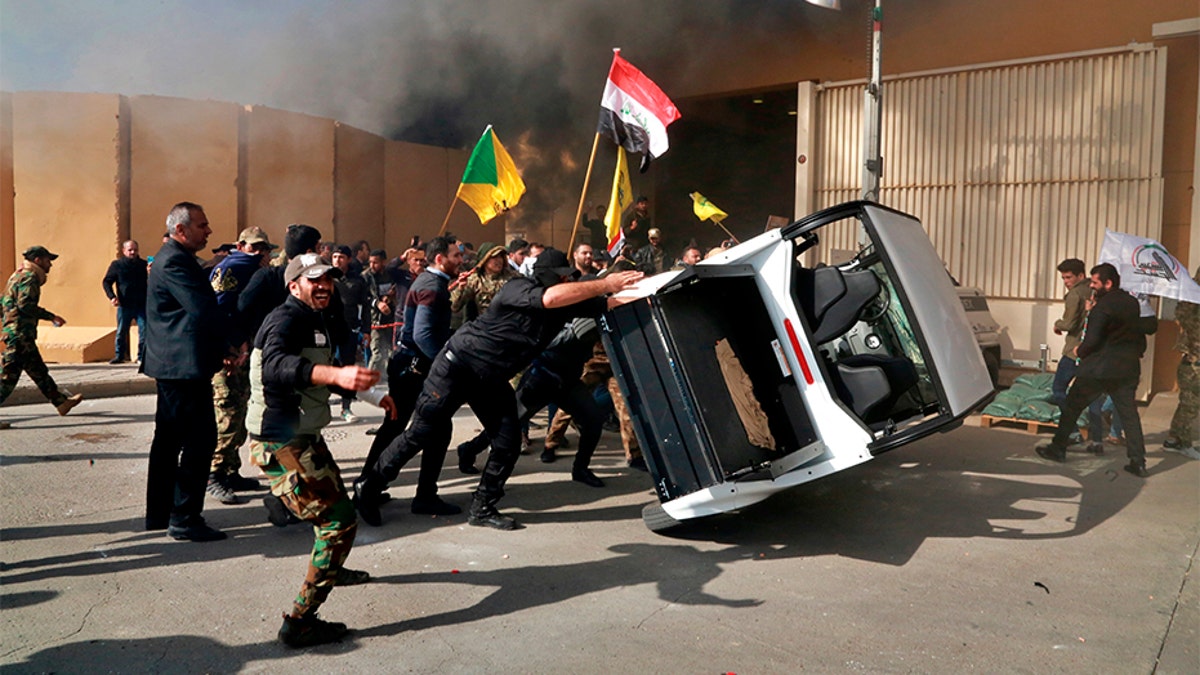Iran vows to push all US forces out of Mideast region
Iran proxies have the potential to re-ignite conflict; Trey Yingst reports from Baghdad.
The killing by the U.S. of Iranian Gen. Qassem Soleimani on Jan. 3, 2020 – and the Iranian airstrikes against American bases in Iraq that followed – are just the latest flare-ups between two nations that have had tense relations over the past few decades. Read on for some of the key moments in history that have impacted the way the two countries interact with each other today.
1979 – The Iranian Revolution
After Iranians overthrow the U.S.-backed shah, Ayatollah Ruhollah Khomeini returns from exile and seizes command of the newly established Islamic Republic of Iran. In November, militants storm the U.S. embassy in Tehran and proceed to hold 52 Americans hostage for 444 days. During that time span, the Jimmy Carter administration froze Iranian assets, severed diplomatic ties and banned American exports to the country.

Iranian students climb over the wall of the U.S. embassy in Tehran in November 1979. (STR/AFP via Getty Images)
A secret attempt to rescue the hostages in 1980, dubbed “Operation Eagle Claw,” resulted in failure and the deaths of eight American servicemen. After extensive diplomatic mediation, the U.S. embassy hostages were released on Jan. 20, 1981, shortly after Ronald Reagan took the oath of office.
1980s – U.S. sides with Iraq in Iran’s war with neighbor
The U.S. takes the side of Saddam Hussein in the Iran-Iraq war, a bloody, eight-year conflict that resulted in the deaths of around 1.5 million people. In the longest conventional war of the 20th century, the two countries fired missiles at each other's cities, Iran sent waves of youngsters to death on the front lines, and Iraqi warplanes bombed Iranian schools and even a jetliner unloading passengers at an Iranian airport.
Hussein had turned to the U.S., France and Britain for weapons, which those countries sold him to prevent an outright Iranian victory. An estimated 5,000 Kurds died in a chemical weapons attack launched by Hussein in the town of Halabja in March 1988. The United States suggested at the time that the Iranians may have been responsible.
1983 – U.S. Embassy, Marines attacked in Lebanon
The Iranian-backed Hezbollah terrorist group is blamed for the bombings of the U.S. Embassy in Lebanon and attacks on the U.S. Marine Corps in Beirut, which left a combined 258 Americans dead. In April, a suicide bomber crashed a truck into the U.S. Embassy there, detonating around 2,000 pounds of explosives and killing 17 Americans – some of which were CIA officers – in the process.

U.S. Marines search for survivors and bodies in the rubble -- all that was left of their barracks in Beirut -- after a suicide car bomb was driven into the building and detonated in 1983, killing 241 U.S. service members and wounding over 60. (LightRocket via Getty Images)
In October, 241 U.S. military personnel were killed when suicide bombers detonated two trucks of explosives at military barracks in Lebanon in the first major terrorist attack against the U.S. The attack was the deadliest day for the United States Marine Corps since the Battle of Iwo Jima in World War II and produced the highest death toll for the U.S. military since the first day of the Tet Offensive in the Vietnam War.
1984 – U.S. lists Iran as a state sponsor of terrorism
The Reagan administration designates the Islamic Republic as being a state sponsor of terrorism. Decades later, the U.S. State Department – in its Country Reports on Terrorism 2018 – said Iran is still the “world’s worst state sponsor of terrorism.” The Tehran regime has spent nearly $1 billion per year to support terror groups "that serve as its proxies and expand its malign influence across the globe," the State Department said. Those groups include Hezbollah, Hamas and the Palestinian Islamic Jihad.
1988 – U.S. mistakenly shoots down Iranian passenger jet, killing 290
The cruiser USS Vincennes, operating in the Persian Gulf following naval activity there between the two countries, mistakes Iran Air Flight 655 as being an Iranian F-14 fighter jet and shoots it out of the sky. The U.S. says the Navy made 11 radio warning calls on different frequencies before the Vincennes fired two missiles at the airplane, bringing it down and killing all 290 aboard.

About 10,000 Iranians attend a 'Death to America' rally that was also the funeral for 72 of the 290 passengers and crew members killed aboard Iranian Air Flight 655 in 1988. (AP)
The deaths, which included 66 infants and children, sparked a national outcry in Iran. Two years later, the U.S. further angered Iran by giving USS Vincennes Capt. William C. Rogers the country’s Legion of Merit award for his military service. The Islamic Republic ultimately would sue the U.S. over the incident, reaching a $132 million settlement.
1995 – Clinton imposes far-reaching oil, trade sanctions
President Bill Clinton, warning that “Iran's appetite for acquiring nuclear weapons and the missiles to deliver them has only grown larger,” announces sweeping sanctions against the Islamic Republic.
“This is not a step I take lightly,” he said at the time, “but I am convinced that instituting a trade embargo with Iran is the most effective way our nation can help to curb that nation's drive to acquire devastating weapons and its continued support for terrorism."
2002 – President Bush labels Iran as part of "Axis of Evil”
In his State of the Union address, the first after the 9/11 terrorist attacks, President George W. Bush groups Iran with Iraq and North Korea as being part of an “axis of evil.” He said “states like these, and their terrorist allies, constitute an axis of evil, arming to threaten the peace of the world. By seeking weapons of mass destruction, these regimes pose a grave and growing danger.” Washington later releases information about Iran operating a secret nuclear program.
2011 – U.S. foils Iranian plot to kill Saudi ambassador on American soil
The Obama administration accuses Iranian government agents of plotting to assassinate Adel Al-Jubeir, the ambassador of its rival Saudi Arabia, while he was in America. Justice Department officials said two men, including a member of the Iran Revolutionary Guards’ elite Quds Force, tried to hire a purported member of a Mexican drug cartel to carry out the assassination with a bomb attack while Al-Jubeir dined at his favorite restaurant.

Saudi Arabia's Foreign Policy Adviser Adel-Al-Jubeir was the target in a foiled assassination plot in 2011. (Reuters)
Yet the would-be killer was a paid government informant and told U.S. authorities all about their plot, which they code-named "Chevrolet." Then- FBI Director Robert Mueller said many lives could have been lost. But Preet Bharara, the U.S. attorney in Manhattan, said no explosives were actually placed and no one was in any danger because of the informant's cooperation with authorities.
2018 – Trump pulls U.S. out of landmark nuclear deal with Iran
President Trump announces that the U.S. is backing out of a 2015 nuclear deal struck by the Obama administration, world powers, and Iran, in which sanctions against Tehran had been lifted in exchange for Iran’s cooperation in restricting its nuclear program. Calling the agreement “defective at its core”, Trump re-imposes devastating sanctions against Iran, which forces the Islamic Republic’s economy into a deep recession.

Protesters damage property inside the U.S. embassy compound, in Baghdad, Iraq, on Dec. 31, 2019. (AP)
2019 – Iran launches brazen attacks in the Middle East
Iran, after the U.S. in April designated its Revolutionary Guard Corps as a terrorist organization, is accused of being involved in a number of incidents throughout the Middle East. In mid-June, two oil tankers were attacked in the Gulf of Oman near the strategic Strait of Hormuz in what Secretary of State Mike Pompeo blamed Iran for and called a "blatant assault."
Days later, Iran shot down a U.S. Navy drone over the Strait of Hormuz. U.S. military officials called the strike an “unprovoked attack” in international airspace, while Iranian officials disagreed, claiming the drone had “violated” its airspace. In July, Iran seized a British-flagged oil tanker in the Strait of Hormuz and briefly detained another.
A missile and drone attack in September 2019 on a facility owned by Saudi Arabia’s Aramco state-run oil company, which U.S. officials say was launched from Iranian soil, knocked out 5.7 million barrels of daily oil production — or more than 5 percent of the world's daily crude production. Then in December, a rocket attack the U.S. says was carried out by Iranian-backed Iraqi militias left an American defense contractor dead. Iran later was accused by President Trump of orchestrating an attack on the U.S. Embassy in Baghdad on New Year’s Eve.
Fox News’ Cristina Corbin, Melissa Leon, Elizabeth Zwirz, Lucas Tomlinson, Stephen Sorace, and The Associated Press contributed to this report.






















